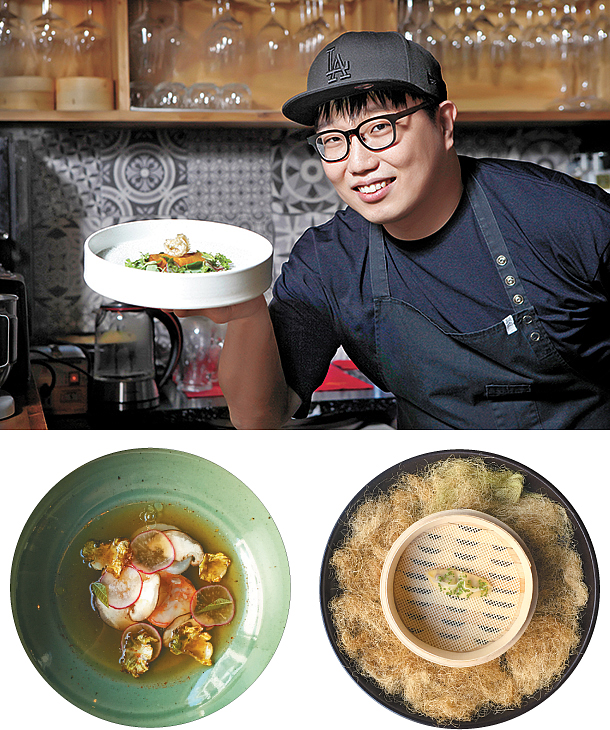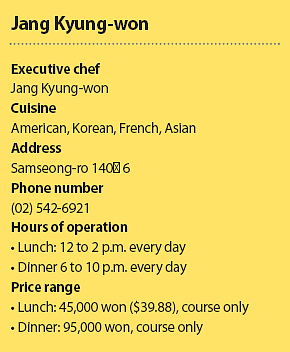Bringing out the most in local flavors to meet the tastes of loyal diners

Chef Jang Kyung-won, top, poses with a potato dish at his restaurant exquisine in southern Seoul. Above are some of the dishes currently being served at the restaurant. At left is a seafood soup and at right is a dumpling made with local corn. [PARK SANG-MOON, LEE SUN-MIN]
“We tried making the risotto differently for you since you said what you had before was a bit heavy for your palate,” said Jang Kyung-won, the executive chef of the restaurant with about 16 seats. “Hope you like it more this time.”
Did he really remember comments from a random guest who visited over a month ago? A few weeks prior, on my first visit, I told the chef that I personally thought that the dish I had eaten would have been better if it had more pickled scallions on top so that the entire dish could be more balanced.
I wondered whether he remembered most of his guests.

“My cooking ends when diners clear what was served to them, not when I finished cooking and the dish leaves my hand,” said Jang.
“No matter how much effort I put into making a dish tasty and unique, if the customer doesn’t like it, I consider that particular dish an incomplete version that needs an update.”
Jang always pays attention to what each guest leaves on their plate. He fastidiously writes down comments he gets from diners. Chefs take turns working in the front of the house to take orders from customers. The communication is direct so the cooking staff can be quick and accurate when making updates to dishes.
If regular diners are feeling adventurous and want to try more diverse ingredients the next time they visit, the chef goes beyond the menu and prepares other ingredients, such as donkey meat or beef aged for up to four months in his kitchen. For more conservative customers, who come for their favorite dishes on the menu, the chef minimizes the number of variations.
“I do this because it is fun for me, and also makes guests’ dining experience more satisfying,” said Jang.
“I want to ensure that my restaurant [is not too rigid,] and is willing to make many variations of the same dishes as long as diners also think it is fun.”
Jang’s food, which looks like Western-style cuisine, attracts customers of all ages, who often think what they are getting is Korean food. The trick comes with Jang’s use of fermented fish and its juices. Even when he serves Beef Wellington, many guests still consider the dish to be Korean, the chef said.
The use of these juices gives his dishes a distinct explosive umami found in local cuisine. Koreans often use broth made with a mixture of seafood such as anchovies or seaweed called dasima when cooking stews, noodle soups or even steamed vegetables to create a flavor that is known in Korean as gamchilmat. So the dishes made with enough use of such broth offers a taste that local diners can easily identify as Korean. The umami enhanced with different types of extra fermented add-ons isn’t so foreign for international diners as well, and they simply think that gamchilmat has been maximized and consider the dish an extension of what they are familiar with in their own local cuisine. So, Jang continues to mix and match different sauces or additives that don’t show on the plate but enhance the dish’s flavor.
“The taste isn’t overly stimulating, but makes you roll your tongue around the walls, floors and ceiling of your mouth to get every last bit of the lingering taste,” explains Jang.
Jang also tries to focus on local produce, even when certain items are known to be lacking in flavor when compared to imported ingredients. Jang thinks that using products made outside of his kitchen makes it that much harder for him to add his own distinct style to his dishes. The chef creates international dishes using local ingredients. When he wants to serve chorizo, he make his own with dried pepper powder he has fermented instead of buying from a local butcher. This is his way of showing local farmers that they have a market of professional chefs like himself.
“My goal is to localize everything I use,” said Jang. “Right now, some base ingredients may lack in flavor ... but if I keep using local ingredients and amend any shortcomings in flavor or texture with my technique and cooking skills with different sauces, that will provide those who produce the ingredients with a steady income so that they can develop better-quality ingredients in the future.”
BY LEE SUN-MIN [summerlee@joongang.co.kr]










with the Korea JoongAng Daily
To write comments, please log in to one of the accounts.
Standards Board Policy (0/250자)